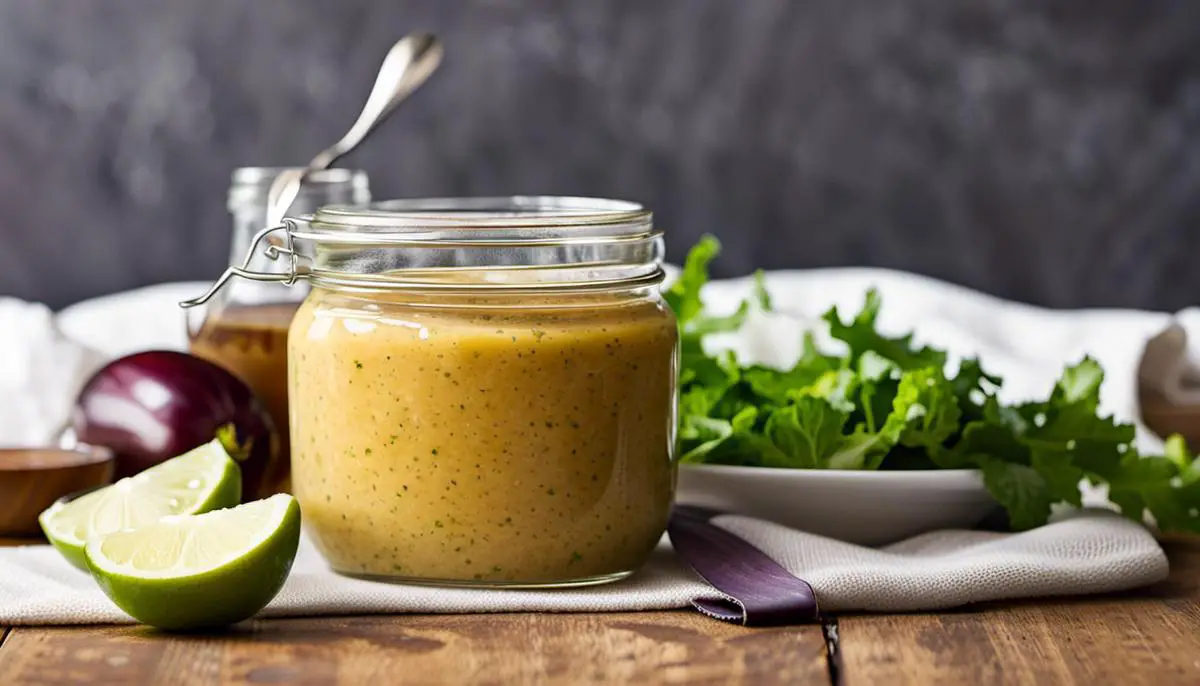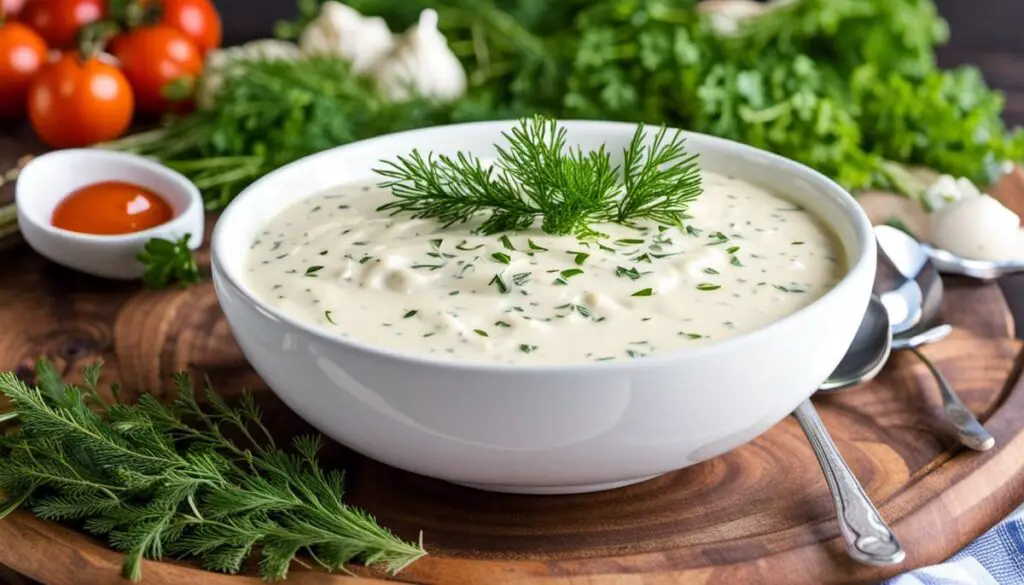Embodying the quintessential flavors of the South, a delectable Southern salad dressing brings a refreshing and tangy twist to any bowl of greens. Thoroughly understanding each ingredient and the roles they play can dramatically transform your culinary journey. This knowledge opens the door not only to mastering the classic recipe, but also to exploring countless variations tailored to your preferences. Whether it’s whipping up a batch of rustic buttermilk dressing or giving a crunchy salad a silky appeal with a velvety mayonnaise blend, the versatility of Southern salad dressings is virtually endless. In addition to this, the art of appropriate serving and storage ensures maximum freshness and flavor, making every meal one to remember.
Understanding the Basic Ingredients
Buttermilk: A Southern Staple
Buttermilk serves as the base of many Southern salad dressings, creating a tangy, creamy base that complements a variety of salads. It has a rich, slightly tart flavor that lends complexity to dressings. If you can’t find buttermilk, you can substitute it with a combination of milk and lemon juice or vinegar. Usually, for each cup of buttermilk, you can use a cup of milk mixed with a tablespoon of lemon juice or vinegar, and let it sit for about 10 minutes before use.
Mayonnaise: Enhancing Creaminess
Mayonnaise is used to add creaminess and thickness to Southern salad dressings. It carries flavor well, amplifying the tastes of the other ingredients. Can’t find mayonnaise? Greek yogurt or sour cream can be substituted in for mayonnaise, although this will slightly alter the flavor, making the dressing tangier.
Garlic Powder and Onion Powder: Flavor Enhancers
Garlic and onion powders lend a savory depth to the dressing. They create a more robust and complex flavor profile without overpowering the other ingredients. Fresh garlic and onions can be used alternatively preferably by grating them to achieve a similar fine texture like the powders.
Dried herbs: A Kiss of Aroma
Dried herbs, like oregano, parsley, and dill, give your salad dressing an aromatic lift. These herbs add layers of flavor and can be customized based on personal preference. If unavailable, fresh herbs can be used. Generally, you need about three times the quantity of fresh herbs as dry since dried herbs are more concentrated in flavor.
Remember, every great Southern salad dressing is based on balance. Each ingredient plays a crucial role in the final flavor profile, enhancing the overall taste of the salad. Start with these basic components and feel free to experiment and adjust according to your palate.

Learning the Mixing Process
Prepare Your Ingredients
Before commencing the mixing process, prepare all your ingredients. Depending on your specific southern salad dressing recipe, this could mean gathering and measuring out ingredients such as olive oil, vinegar, lemon juice, Dijon mustard, honey, salt, and pepper. If your recipe calls for fresh herbs like parsley, thyme or basil, ensure they’re finely chopped.
Choose Your Tools
For this process, you will need certain tools to help you mix the ingredients effectively. It is generally recommended to use a medium to large bowl to mix your dressing and a whisk for a well-emulsified result.
Whisking up the Ingredients
To begin mixing, start with your acid and your emulsifier. In this context, your acid refers to ingredients like vinegar or lemon juice, while your emulsifier usually is your Dijon mustard or honey. Whisk these together until they are thoroughly combined. The emulsifier works to help bond the liquid like vinegar or lemon juice and oil together, creating a thick and even consistency.
Drizzling the Oil
Now is the time to drizzle in your oil while continuously whisking. For a dressing, you’ll typically use olive oil or other similar options. Slowly pouring the oil while whisking helps to better combine the oil and acid, preventing the two from separating later.
Seasoning the Dressing
With all elements combined to a homogenous mixture, add your salt, pepper, and any other spice your recipe specifies. Continue whisking until these are well distributed within the dressing.
Adding Fresh Herbs
The final step requires adding any fresh herbs that your recipe includes for freshness and flavor. Since these don’t require a thorough mix like previous steps, you can either whisk them in gently or simply stir them with a spoon.
Checking the Dressing’s Consistency
To conclude the mixing process, ensure the dressing’s consistency is to your liking. A well-blended dressing should be neither too thick nor too runny, with an even blend of all ingredients. If the dressing is too thick, you can thin it out by adding a little more acid. Conversely, if it’s too thin, add more oil while whisking until you achieve the desired consistency.
Remember to taste your dressing and adjust the seasonings as necessary. You now have a well-blended, homemade southern salad dressing ready to enjoy!

Variations of Southern Salad Dressing
The Basic Southern Salad Dressing Recipe
The basic Southern salad dressing recipe involves just a few key ingredients: 3/4 cup of mayonnaise, 1/4 cup of white vinegar, 2 tablespoons of sugar, and salt and pepper to taste. The first step is to combine all the ingredients in a bowl and whisk until smooth. The dressing can be used immediately or stored in the refrigerator for up to two weeks.
Creating Variations
Variations of this Southern salad dressing can be achieved with a few simple tweaks. For a tangier dressing, add 1-2 tablespoons of lemon juice. This will not only add a burst of acidity, but also brighten the overall flavor of the dressing. To make the dressing sweeter and less tangy, add a tablespoon of honey or brown sugar in place of the regular sugar. Another option includes adding mustard or Worcestershire sauce for an extra punch and deeper flavor. If you enjoy a richer, creamier texture, try mixing in a spoonful of sour cream or Greek yogurt. And for some heat, a few dashes of hot sauce or a pinch of cayenne pepper would certainly do the trick.
Experimenting with Seasonings
Experimenting with seasonings is another route in exploring the different versions of Southern salad dressing. Dried or fresh herbs such as chives, basil, and parsley can be incorporated. For a garlicky twist, put in a clove of minced garlic or a sprinkle of garlic powder. The possibilities are virtually endless when it comes to playing around with flavors.
Understanding Salad Green Pairings
When it comes to pairing your Southern salad dressing with salad greens, the type of greens plays a crucial role. For example, sturdier greens such as romaine, kale, and iceberg lettuce hold up well under the weight of this creamy dressing. The tangy variations go well with peppery greens like arugula or watercress. On the other hand, delicate greens like baby spinach or field greens marry well with a sweeter version of this dressing.
By understanding and applying these tweak techniques, you can enjoy countless variations of traditional Southern salad dressing that can complement a wide range of salads.

Storing and Serving Dressing
Storing Southern Salad Dressing
To preserve the freshness of your homemade southern salad dressing, it is best to store it in a clean, airtight container such as a jar or bottle. Glass is the preferred choice as it is non-reactive and will not alter the taste of the dressing. It should be kept in the refrigerator for optimal preservation. This will help slow down the spoilage process and keep the ingredients fresh. Most dressings can safely be stored for up to two weeks, though some may last longer depending on the ingredients used. Always take note of the expiration dates of your ingredients, as they could affect the overall stability of the dressing.
Serving Southern Salad Dressing
When serving your southern salad dressing, it should be cold or at most, room temperature. To avoid overdressing the salad, serve the dressing on the side or drizzle a small amount before tossing the salad. This gives everyone the option to add as much or as little dressing as they’d prefer. Mix the dressing well before serving as the oil and other ingredients may separate while in storage.
Pairings for Salad with Southern Dressing
Southern salad dressing, characterized by its tangy, creamy and slightly sweet flavor profile, is versatile and can pair with a variety of salads and dishes. The classic pairing is with a simple mixed salad comprising lettuce, tomatoes, cucumbers, and red onions. However, its bright flavor also melds well with robust salad ingredients such as kale, grilled chicken, or roasted vegetables.
As for the dishes, this dressing blends beautifully with staple southern cuisine such as fried chicken, shrimp and grits, or even a platter of barbecue. It aids in balancing out the rich, hearty flavors typical of southern dishes. As this dressing complements a range of ingredients, it allows you to be creative and experimental in crafting meals that suit your palette.

A Southern salad dressing is a culinary delight that efficiently combines simplicity, versatility, and a depth of flavor. Understanding its ingredients, mastering the mixing process, exploring its varieties, and knowing how to store and serve it can significantly enhance your kitchen skills. Moreover, it provides room for creativity with substitutions and additions according to taste or dietary needs. From the succulent base formed by creamy mayonnaise and buttermilk to the robust burst of seasonings, this dressing is a true Southern classic. And with the understanding of the right pairings, each salad dressed with this delectable concoction emerges as a symphony of tastes that elevates ordinary meals to extraordinary dining experiences.






